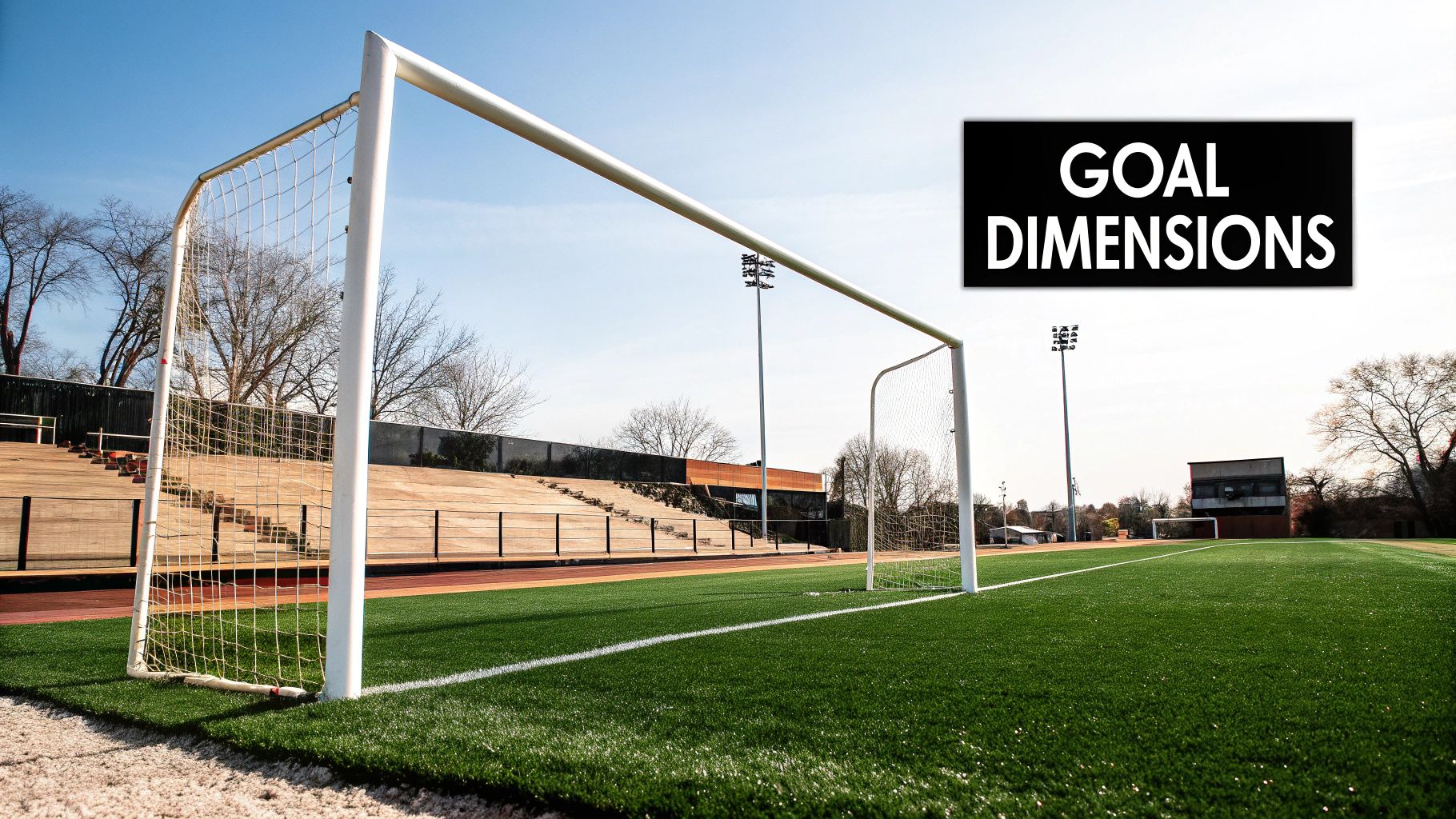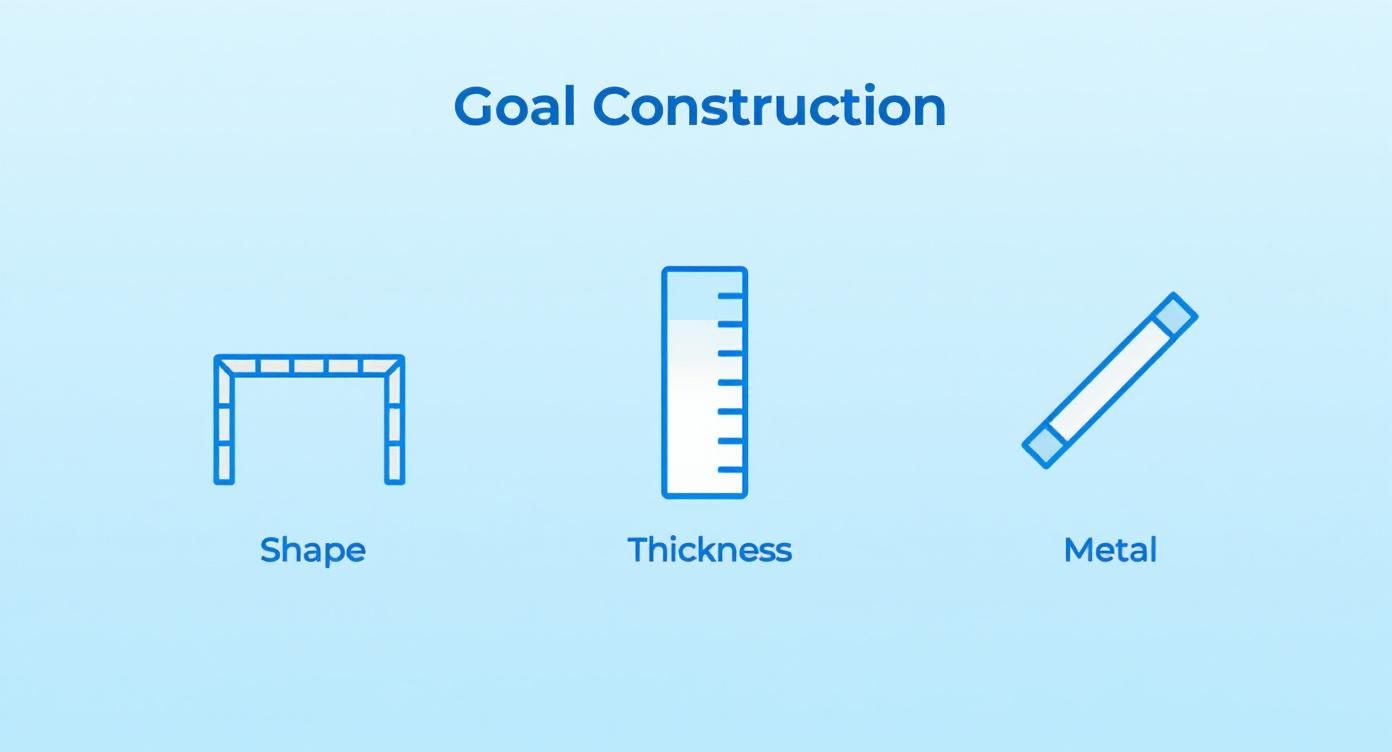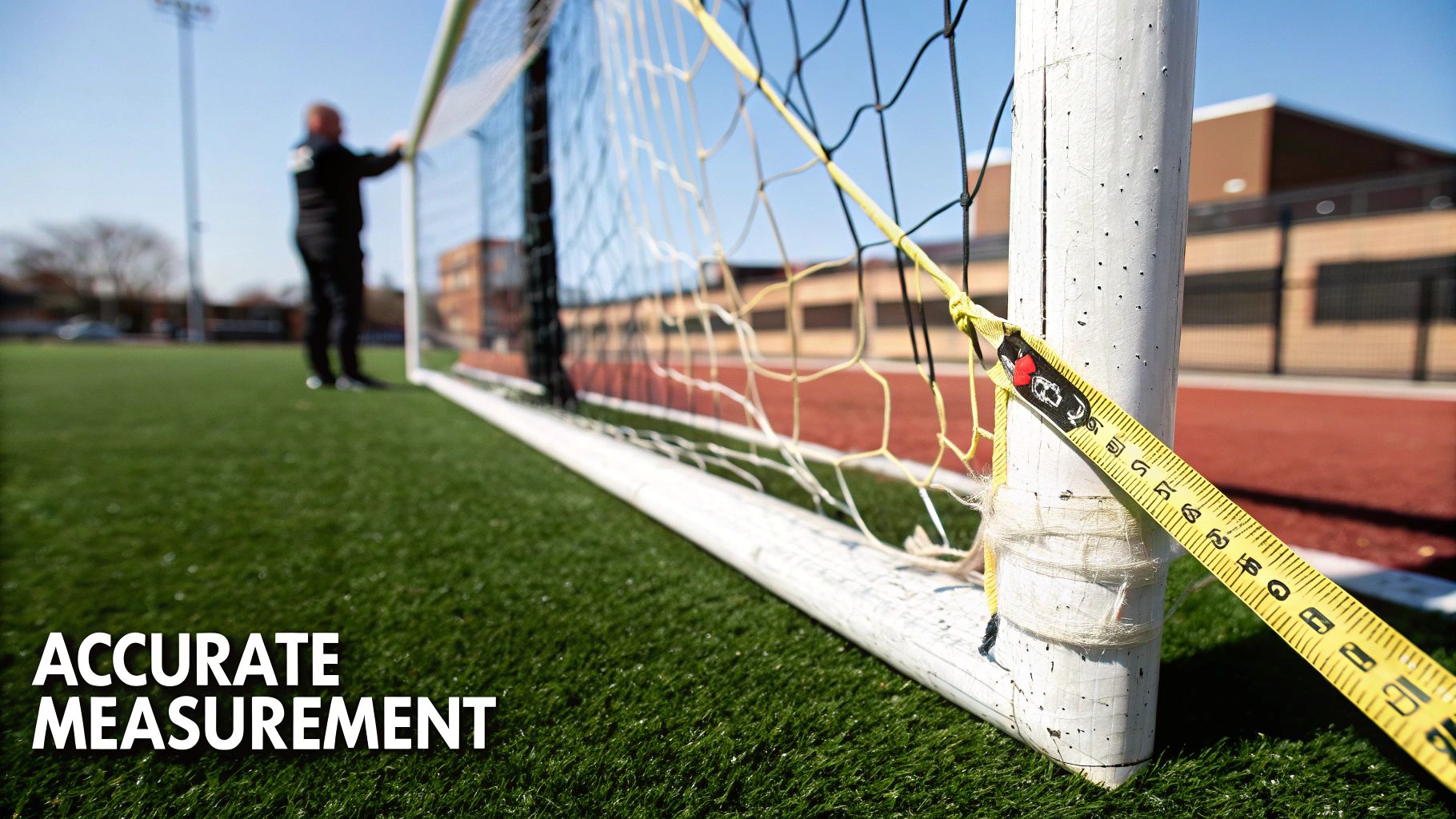Getting the dimensions of a full size football goal spot-on is fundamental for any official 11-a-side match. The standard size, set at 8 feet high by 8 yards wide, literally defines the target for senior football played across the UK and the rest of the world.
Official 11-a-Side Football Goal Dimensions
When setting up a pitch for a senior game, every measurement must meet the strict standards laid down by governing bodies like The Football Association (FA) and the International Football Association Board (IFAB). Following these regulations is non-negotiable, ensuring fairness and consistency whether you’re playing at a local park or in a professional stadium.
The required internal dimensions, measured from the inside of one post to the other, have been a core part of the game for well over a century. In fact, the standard size of a full-size goal in the UK has barely changed since the 19th century. According to the original FA rules set in 1863, the goal's width must be exactly 8 yards (7.32 metres) between the posts. The height, measured from the ground to the underside of the crossbar, is fixed at 8 feet (2.44 metres). You can find out more about the history behind these goal sizes.

Key Measurements At A Glance
Here's a quick reference table breaking down the critical dimensions every full-size football goal must meet. These figures are crucial for groundskeepers, coaches, and league officials to ensure all equipment is compliant and match-day ready.
Official 11-a-Side Football Goal Dimensions
| Measurement | Imperial (UK) | Metric (International) |
|---|---|---|
| Internal Width | 8 yards (24 feet) | 7.32 metres |
| Internal Height | 8 feet | 2.44 metres |
| Post/Crossbar Thickness | Max. 5 inches | Max. 12 cm |
This consistency is vital. It ensures that a shot aimed at the top corner in one stadium is the exact same challenge as a shot in any other. The maximum thickness for the posts and crossbar also plays a key role in fair play, preventing teams from gaining an unfair advantage with overly chunky frames.
The History of Standardised UK Goal Sizes

The precise full size football goals dimensions we see on every pitch today weren't always a given. In the early days of the beautiful game, goals were often makeshift. Players used anything from two sticks pushed into the ground to a couple of top hats to mark out the scoring area.
As you can imagine, this caused chaos. There was no crossbar, and the width could be wildly different from one match to the next. For football to grow from a disorganised kickabout into a serious, competitive sport, something had to change.
The FA Steps In
The turning point arrived in the mid-19th century when The Football Association (FA) was formed. This new governing body was tasked with creating a proper rulebook to bring much-needed order to the game. One of their first, and most important, decisions was to standardise the goal.
You might be surprised to learn that some early matches, dating back to 1801, used goals marked by sticks just a few feet apart. This all changed in 1863 when The FA officially set the goal width at 24 feet. By 1865, a tape was introduced to act as a crossbar at a height of 8 feet. You can read more about the evolution of nets over on huck-net.co.uk.
This was a massive step forward. It created a level playing field and started to define the core skills needed for both attacking and defending.
From Tape to Solid Crossbar
That first "crossbar" was literally just a tape stretched between the posts. While better than nothing, it was far from perfect. It sagged in the middle, leading to endless arguments about whether a powerful shot had gone under or over it.
This problem led to the final piece of the puzzle: making a solid crossbar mandatory. This simple but brilliant change cemented the full size football goals dimensions we all recognise today, creating an undeniable target. This UK-led innovation set the standard for the entire world, shaping football for every generation since.
Goal Construction and Material Specifications
It’s not just the full size football goals dimensions that matter. The way the posts and crossbar are built is just as critical for safety, fairness, and how the ball reacts when it hits the frame. Official regulations are incredibly detailed to ensure no team gets an unfair advantage from their equipment. These rules cover everything from the shape of the posts to the materials they're made from.
According to IFAB’s Laws of the Game, the posts and crossbar must be made from an approved material and must not be dangerous to players. They can be square, rectangular, round, or elliptical – or a combination of these shapes. This standardisation is key to preventing unpredictable deflections off the woodwork.
Post and Crossbar Thickness
One of the most important rules concerns the thickness of the goal frame. Both the posts and the crossbar must be the same width and depth, which cannot be more than 12cm (5 inches). This rule is in place for two very good reasons:
- Player Safety: Capping the thickness helps reduce the severity of an injury if a player collides with the frame during a match.
- Competitive Fairness: It guarantees a consistent goalmouth target on every pitch. No team can install thicker posts to make the goal smaller and harder to score in.
Common Goal Materials
The material a goal is made from significantly affects its durability, weight, and suitability for different environments. For full-size goals, you’ll almost always find they're made from either aluminium or steel, each with its own strengths.
Aluminium is a popular choice because it's strong but surprisingly light. This makes it perfect for portable goals that need to be moved for training drills or on multi-use pitches. Steel, on the other hand, is much heavier and tougher, providing brilliant durability for permanent, fixed goals that have to withstand constant use and harsh weather.
The decision between them comes down to a club or facility's specific needs. Of course, the frame is only half the story; you can dive deeper into the different types by checking out our guide on football goal nets.
A Complete Guide to Different Football Goal Sizes
While the classic 8ft x 24ft goal defines the senior 11-a-side game, football is played in countless formats across the UK. To ensure the game is fair, enjoyable, and helps players develop properly, The FA has set out official goal sizes for every age group. It’s all about scaling the target down to match smaller pitches and fewer players on the field.
This approach is crucial for building confidence in younger players. Imagine an under-8s keeper trying to defend a full-size goal—it would be an impossible and demoralising task. Smaller goals for 5-a-side or 7-a-side matches create a realistic challenge that's proportional to the players themselves.
Youth and Small-Sided Football Goals
As children move up through the age groups, the goals get progressively larger. The FA’s guidelines ensure that a player in Manchester is shooting at the same size target as a player in Cornwall, creating consistency across the grassroots game.
Here’s a quick breakdown of the most common formats:
- 5-a-Side (Under-7s/8s): The smallest official goal, measuring 6ft wide by 4ft high (1.8m x 1.2m).
- 7-a-Side (Under-9s/10s): The goal size increases to 12ft wide by 6ft high (3.7m x 1.8m).
- 9-a-Side (Under-11s/12s): This transitional format uses goals that are 16ft wide by 7ft high (4.9m x 2.1m).
And let's not forget futsal. The popular indoor version of the game has its own specific goal dimensions, requiring a target that is 3m wide by 2m high (9.8ft x 6.6ft). This size is perfectly suited to the fast-paced, technical nature of the sport.
UK Football Goal Size Guide By Format
To give you a clearer picture, we've put together a handy reference table. This breaks down the official FA goal dimensions for the most common football formats played in the UK, from the youngest players just starting out all the way up to the senior game.
| Format | Recommended Age Group | Goal Width | Goal Height |
|---|---|---|---|
| 5-a-Side | Under 7s & 8s | 6ft (1.8m) | 4ft (1.2m) |
| 7-a-Side | Under 9s & 10s | 12ft (3.7m) | 6ft (1.8m) |
| 9-a-Side | Under 11s & 12s | 16ft (4.9m) | 7ft (2.1m) |
| 11-a-Side | Under 13s & 14s | 21ft (6.4m) | 7ft (2.1m) |
| 11-a-Side | Under 15s+ & Senior | 24ft (7.3m) | 8ft (2.4m) |
| Futsal | All Ages | 3m (9.8ft) | 2m (6.6ft) |
Using the right size goal isn't just about following rules—it's about creating the best possible environment for players to develop their skills and, most importantly, enjoy the game.
The infographic below dives deeper into what makes a good goal, looking at everything from the shape to the materials used in its construction.

As you can see, there’s more to it than just the dimensions. Structural integrity and choice of material are vital for both performance and safety, no matter the size. Many of these smaller goals are also designed to be moved around easily, which you can learn more about in our guide to portable soccer goals. Understanding these different sizes is essential for any coach, parent, or player involved in grassroots football.
UK Safety Standards for Football Goals
Getting the dimensions right is one thing, but ensuring your goals are safe is a different ball game entirely. For any club, school, or local authority in the UK, player safety isn't just a priority—it's a non-negotiable responsibility. Football goals must meet strict British and European standards to prevent injuries, and ignoring these regulations can have serious consequences.
The two main certifications you need to know are BS EN 748 and BS EN 16579. These don't just cover size and shape; they cover the nuts and bolts of a goal's construction, from its structural strength to its stability on the pitch. These standards ensure a goal can withstand a full-force strike without collapsing.
Key Safety Requirements
A huge part of these safety standards is preventing entrapment. The regulations are incredibly specific about the size of gaps in the goal frame and how the net is fixed, all to ensure a player's head, neck, or limbs cannot get stuck. This detail is vital, especially for protecting children in grassroots football.
Another critical point is anchoring. Every freestanding or portable goal must be securely anchored down every time it's used. It sounds like common sense, but a goal that isn't fixed properly can tip over with terrifying ease, and tragically, this has led to fatal accidents in the past.
An unanchored goal is a genuine hazard. Safety experts state it only takes around 140 pounds (approximately 63.5 kg) of force to tip over a full-size goal. That's a force easily generated by a teenager swinging on the crossbar or even a strong gust of wind.
Choosing Compliant Goals
When buying new goals, always check that they are certified to meet these standards. Any reputable supplier will make it clear whether their products are compliant. This is your guarantee that the goals have been properly stress-tested for strength and stability.
Here’s a quick rundown of what the safety standards cover:
- Structural Stability: The goal must be stable and not tip over during normal play or even predictable misuse (like someone hanging from the crossbar).
- Strength Testing: The frame must handle specific loads without breaking or bending permanently.
- Entrapment Prevention: All openings and gaps are designed so that body parts cannot get trapped.
- Anchoring Systems: The goal must come with clear instructions and effective methods for securing it to the ground.
For anyone managing a facility or running a club, buying certified equipment is one of the most important things you can do to create a safe playing environment. To help you choose the right equipment, you can explore our detailed guide on full size football goals, where we break down exactly what to look for.
How to Measure Your Football Goal Accurately
Ensuring the full-size football goal dimensions are spot-on is a non-negotiable part of match-day preparation. Get it wrong, and you open the door to arguments and questions over the game’s fairness. This is a straightforward guide to doing it right, so anyone can check their goals with complete confidence.

To nail this, all you need is a reliable tape measure. The key thing to remember is that official dimensions are always taken from the inside of the goal frame, never the outside.
Step-by-Step Measurement Process
Follow these two simple steps, and you’ll know your goal meets official FA and IFAB regulations. It's a foolproof method that removes all guesswork.
-
Measuring the Width: Run your tape measure from the inside edge of one goalpost straight across to the inside edge of the other. Make sure the tape is pulled tight and runs parallel to the ground. For a senior 11-a-side goal, this measurement must be exactly 8 yards (24 feet or 7.32 metres).
-
Measuring the Height: Start with the end of your tape measure on the ground, right on the goal line. Now, measure straight up to the bottom edge—the underside—of the crossbar. This distance must be precisely 8 feet (2.44 metres).
A word of warning: a common mistake is measuring to the top of the crossbar. Always measure from the ground to the underside. Including the thickness of the crossbar will give you an incorrect reading every time.
And that’s it. This quick two-step check is all it takes to confirm your goal is up to spec. Doing this regularly is good practice—it maintains professional standards and ensures every game is played on a level playing field.
Frequently Asked Questions
To round things off, let's tackle some of the most common questions people have about full size football goal dimensions and other related rules. It’s easy to get lost in the details, but getting them right is crucial for anyone involved in the beautiful game.
Are Premier League Goals a Different Size?
No, they are exactly the same. Premier League goals adhere to the official dimensions used for all senior 11-a-side matches: 8 feet high and 8 yards wide, just as The FA and IFAB specify.
The main difference you'll see at the top level is in the quality of the materials and the mandatory technology, like goal-line technology, that's built-in. The dimensions, however, are standard.
What Is the Minimum Pitch Size for Full Size Goals?
According to FA guidelines, the smallest recommended pitch for an adult 11-a-side match is 100 yards (91.4m) long and 50 yards (45.7m) wide. While the goal size is set in stone, pitches have more flexibility and can vary in size to fit different grounds and stadiums.
Why Must Goalposts Be White?
There’s a very practical reason for this. IFAB’s Law 1 clearly states that goalposts and the crossbar must be white. This rule is all about visibility.
The bright white colour stands out against the green pitch and the crowd in the background. It ensures players, referees, and spectators can clearly see the frame of the goal, especially in poor weather or as daylight starts to fade.
Ready to get your pitch kitted out with professional-grade gear? At SoccerWares, we offer a huge range of football goals and training equipment for every level of the game. Check out our collection today and find the perfect setup for your club or even your back garden. Find out more at https://soccerwares.com.

